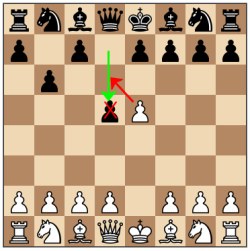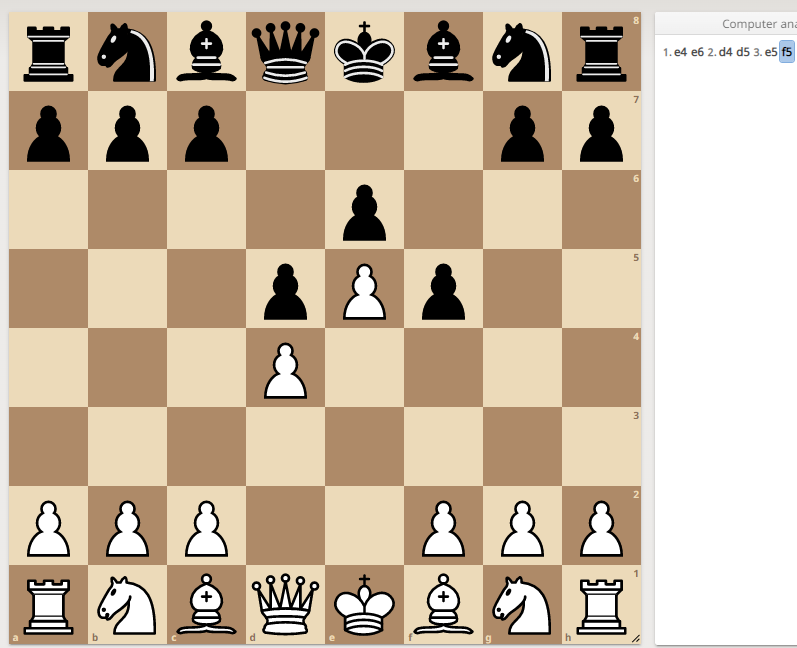
By National Master Evan Rabin

There are two types of special moves in chess- castling and en passant. Most beginners have heard of castling but do not know all the rules about it. Two years ago I was shocked when I was reviewing a 1200 rated student’s game and he didn’t realize that he had the opportunity to do en passant and be up a pawn for nothing. En passant is a fairly rare type of move that means “in passing” in French.
Our 131st podcast guest FIDE Master Sunil Weeramantary explains en passant as “when your pawn moves up two squares and your opponent has a pawn on either of side of it, he could capture you as if you went only one square.”
explains en passant as “when your pawn moves up two squares and your opponent has a pawn on either of side of it, he could capture you as if you went only one square.”
For instance in example up above, back moved his pawn two spaces to d5. White can play exd6, as if black played d6.
Later is too late; en passant needs to happen right after one moves his pawn two squares and his opponent has a pawn on either side of it. For instance, if white plays Nf3 in position above, instead of exd6, he cannot do en passant on the next move.
Many beginners that do know en passant make the mistake of doing it at every opportunity. One should only make a trade, one of the three types of transformational moves, if it benefits his position.
Let’s take a look at this position:

Should white play 4 exf6?…….
No.
Right now, white has a strong control of the center and black cannot develop his kingside knight where it wants to on f6. Playing 4. exf6 will allow black to start freely developing the rest of his pieces with 4… Nxf6.
While en passant does not happen often, it is important for all players to know the rule before they start playing in tournaments. It is best to teach it to children after castling and before basic strategy and adults in the beginning when teaching how the pawn moves.


Excellent and practical
niggardly
hell nah Jit racist thats crazy.
The gateway to endless gaming possibilities.
From classic favorites to innovative new releases, our online casino offers a diverse selection of games to suit every taste and preference.
From classic favorites to innovative new releases, our online casino offers a diverse selection of games to suit every taste and preference.
<a href=”[Link deleted]تعمیرات لپ تاپ لنوو
<a href=” [Link deleted]آل این وان لنوو
<a href=” [Link deleted]تبلت لنوو
Play on the go with our mobile-responsive casino platform!
Although <a href="[Link deleted]dash lite doesn’t have online leaderboards, you can still compete with friends by sharing your best scores.
Although Geometry Dash Lite doesn’t have online leaderboards, you can still compete with friends by sharing your best scores.
سقفهایی که تیرچه کرومیت در ساخت آنها به کار برده میشوند، حفرهدار و شبکهای هستند.
Explore, conquer, and thrive in our online world!
It appears that you know a lot about this topic. I expect to learn more from your upcoming updates. Of course, you are very much welcomed to my website <a href="[Link deleted]about Website Design.
Truly appreciate your well-written posts. I have certainly picked up valuable insights from your page. Here is mine <a href="[Link deleted]about Price Comparison Sites. Feel free to visit soon.
Your writing style is cool and I have learned several just right stuff here. I can see how much effort you’ve poured in to come up with such informative posts. If you need more input about SEO, feel free to check out my website at <a href="[Link deleted]
Great!!! Thank you for sharing this details. If you need some information about Used Car Purchase than have a look here <a href="[Link deleted]
Having read your posts. I believed you have given your readers valuable information. Feel free to visit my website <a href="[Link deleted]and I hope you get additional insights about Search Engine Optimization as I did upon stumbling across your site.
Your ideas absolutely shows this site could easily be one of the bests in its niche. Drop by my website <a href="[Link deleted]for some fresh takes about Memes. Also, I look forward to your new updates.
You absolutely know how to keep your readers interest with your witty thoughts on that topic. I was looking for additional resources, and I am glad I came across your site. Feel free to check my website <a href="[Link deleted]Sphere about Document Management Systems.
ورق استیل 316 با داشتن ترکیب مولیبدن، مقاومت بیشتری در برابر خوردگی و سایش نسبت به ورق استیل 304 دارد. این ورق به ویژه در محیطهای دریایی و صنایع شیمیایی کاربرد دارد. ترکیب شیمیایی این ورق شامل 16 تا 18 درصد کروم، 10 تا 14 درصد نیکل و 2 تا 3 درصد مولیبدن است که باعث میشود خواص مکانیکی و شیمیایی برجستهای داشته باشد. ورق استیل 316 همچنین در دماهای بالا تا حدود 800 درجه سانتیگراد مقاومت خوبی دارد. برای خرید و مشاهده قیمت ورق استیل 316 به وبسایت فولاد مارکت مراجعه کنید و از مشاوره تخصصی ما بهرهمند شوید.
[Link deleted]
thank you. it was very informative.
The gateway to endless gaming possibilities.
thank you. it was very informative.
It’s open-source, meaning anyone can see and modify the code. It’s free and safe to use, and it’s made for Windows computers.
خرید انواع مبل کلاسیک
The online leaderboards are a huge advantage because they allow me to compete against my friends as well as other people from all over the world.
<a href="[Link deleted]waves
تشریفات عروسی و خدمات مجالس نامزدی و عروسی در تهران
Word Games is more than just a game; it’s an intellectual playground where you could enjoyably raise your language skills.
Interesting read on en passant! It’s surprising how often intermediate players overlook such a niche rule. Speaking of common issues people overlook—in the modding community, a lot of users run into problems after updates. If anyone’s struggling with a recent game mod not loading properly, this guide might help resolve compatibility or installation issues:
[Link deleted]
Nulls Brawl özel sunucusu = Sınırsız eğlence + Ücretsiz kostümler + Tüm karakterler açık
En passant is one of those precise chess rules that rewards awareness and strategic timing — mastering it means understanding the subtle interactions behind the move. In mobile gaming, particularly with modded APKs like <a href="[Link deleted]brawl, success often relies on similarly precise mechanics and balance tweaks. Knowing how character stats align and timing abilities play out is just as critical in game meta as recognizing the en passant opportunity on the board.
Great walkthrough — clear, step-by-step installation guides make a big difference for users. When dealing with mod installation like [Link deleted]it’s essential to highlight version compatibility, file structure, and any required configuration steps. Such transparency ensures mod users avoid conflicts and just enjoy stable gameplay.
En passant is a nuanced tactic that rewards precise timing and board awareness — a principle mirrored in software too. In gaming communities, reliable mod platforms like [Link deleted]emphasize version accuracy, file consistency, and installation integrity to ensure gameplay runs as intended. Whether strategizing on a chessboard or managing digital builds, attention to detail determines performance.
En passant is a nuanced tactic that rewards precise timing and board awareness — a principle mirrored in software too. In gaming communities, reliable mod platforms like minecrftjennymod.com emphasize version accuracy, file consistency, and installation integrity to ensure gameplay runs as intended. Whether strategizing on a chessboard or managing digital builds, attention to detail determines performance.
Great end‑of‑year activity ideas — closing chapters with structured reflection can really boost memory and learning. In tech, a similar approach applies to app optimization: incremental updates and clean versioning keep systems efficient. For instance, platforms like nullsbrawl-apk-indir.com.tr manage APK distribution by using clear changelogs, device profiling, and modular release practices to prevent clutter and ensure smooth gameplay. Consistency and transparency matter in classrooms and code.
This was super helpful and easy to follow. Thanks for sharing!If you’re looking for tips to help yourself with today’s NYT
Great post, Evan! It’s surprising how many players, even at 1200, miss en passant. I really appreciated FM Sunil Weeramantary’s clear explanation – it makes such a rare but important move much easier to grasp. Thanks for bringing this “back to basics” chess rule to light!
A matt black minimalist lever adds boldness and sophistication, fitting seamlessly into modern interior designs. Hinges ensure the door opens smoothly, without squeaks or resistance, while locks deliver confidence in security. On this platform, customers are spoiled with choices from world-class collections such as Jedo, Burlington, Hoxton, and Nero, each with its own unique character. Jedo offers practicality with elegance.
With a focus on precision and reliability, this team consistently produces work that meets the highest standards.구글찌라시 Choosing this service means investing in proven expertise and a commitment to delivering beyond standard expectations.
The MOD Menu included in this version gives players special advantages like unlimited sun, no cooldown, enhanced attack power, and easier level completion, which removes restrictions and allows full creative control. The 2025 update improves graphics quality, animation smoothness, and sound effects, making the game visually attractive without losing its classic charm. PvZ Fusion APK V3.0.1 is designed to run efficiently on most Android devices, even those with average specifications, ensuring stable performance and minimal lag.